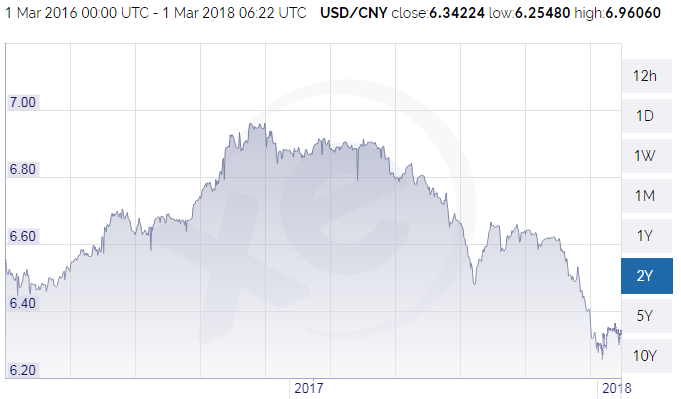China is an economic powerhouse and one of the leading exporting countries in the world. While from the outside the country seems to be unstoppable in getting more market share around the world, China’s exporters are facing one significant problem at the moment. The rising value of the RMB is reducing the profits of enterprises and forcing some to raise quotations, which on the other side reducing the demand and competitiveness overseas.

Source: Xe.com
The Chinese currency Renminbi (RMB) was valued up by the government over the course of 2017 with an annual growth of 6.3%. As a result, the exchange rate from USD to RMB has been changed from 6.9 at the beginning of 2017 to 6.3 at the beginning of 2018.
After all, the higher value of the Chinese RMB is reducing the overall revenue of those exporting enterprises, which are focusing mainly on the overseas profit for their business.
In 2018, RMB continued to get stronger. As of 2 February 2018, the USD/CNY exchange rate was 6.2885. The continuous increases in value are making the export for Chinese enterprises more difficult.
The main problem of the current trend is, if the yuan strengthens against another currency, then China's goods and services become more expensive for people using the other currency, and they may end up buying less of those Chinese goods and services.
For 2018, a change in the appreciation of the RMB is not in sight. According to experts’ opinion, there is potential for strong growth of the Chinese yuan in this year. China’s currency strength has more room to grow. In 2018, the RMB is off to a stronger start than 2017, appreciating by 2.6% versus the US dollar, or over 30% annualised.
Historically, the Chinese currency only moves 6% to 7% in a year. For example, looking back to the year when the Chinese currency moved the most, which was in 2016, a decline of 6.8% was witnessed.
But the higher value of RMB is not only raising problems for the domestic exporters. Also, other countries are complaining about China’s currency value growth. In fact, the development is causing some criticism that the export giant has been deliberately suppressing its currency to gain economic advantage over its trading partners. Some experts even said the world's second-largest economy is also propping up its currency to appease President Donald Trump.
Based on current circumstances, industry insiders consider that Trump's administration will impose heavy tariffs on Chinese commodities, which will intensify Chinese economic downward pressure as well as Renminbi depreciation stress.
However, Chinese policymakers are beginning to worry about a rallying yuan as exporters come under strain, policy insiders say, a sign the currency’s gains might lose steam after it scaled a near two-year top on the dollar. Appreciation is better than depreciation, but the pace of appreciation cannot be too fast, otherwise, it will be unfavourable for domestic firms, according to governmental insiders.
The renminbi is classified as a fixed exchange rate currency with reference to a basket of currencies", which has drawn attention from nations which have freely floated currency and has become a source of trade friction with western nations.
It is worth noticing, that some economists have argued that the value of the renminbi should be allowed to appreciate by even higher degrees, more than 20% against the US dollar. According to the International Monetary Fund, the renminbi is undervalued somewhere between five and 27% at all.
Some Chinese export examples
According to China Customs, the country exported almost 200 thousand tonnes of cornstarch in the first three quarters of 2017, up by 150% over the 78,000 tonnes the same period in 2016. The prosperous export business boosted the domestic market. However, in regards to starch sugar, due to rebounding domestic prices, the appreciation of the RMB, and slumping international sugar prices, China's export volume of starch sugar declined in September down 12.74% YoY.
China's TiO2 market remained stable in the last months. Although some large-scale manufacturers quoted higher prices for their products, no great changes were seen in the actual transaction prices thanks to the appreciation of RMB and sluggish downstream demand.
China's glyphosate prices continued falling in February 2018. The prices in the early month. were lower than the end of January. It is predicted that the prices are unlikely to rise before the Chinese Spring Festival in view of current supply and sale. What's more, the appreciation of the RMB recently also restrains the enthusiasm for export.
The Chinese phosphate fertilizer industry, already suffering from overcapacity problems, is set to face more challenges by the ongoing appreciation of the RMB, which could push many producers, especially DAP producers, to the edge of extinction. If the FOB price of DAP is RMB3300/t, the appreciation of the renminbi from 6.3 to 6.16 to the USD means that prices have risen by USD11.90 per tonne. Chinese DAP exporters have to raise prices or absorb the loss. But overseas buyers won't accept price increases, especially in the current international DAP market. In the meantime, the exchange rate of RMB to USD is still keeping an uptrend. Correspondingly, the pressure to phosphate fertilizer industry posed by the RMB appreciation will continue, let alone the undervalued international DAP price.
About the article
Keeping track of China’s imports and exports can be crucial for healthy business decision. As the RMB is continuing to value up, foreign buyers of Chinese products may get the export data including price and quantity to check the trend and prepare properly for export changes that can occur.
Tranalysis provides official import and export data for China and countries worldwide, including a customized manufacturer to buyer analysis. Contact our team at econtact@tranalysis.com for more information.